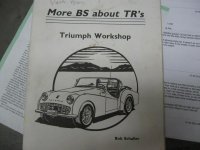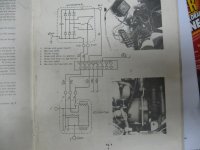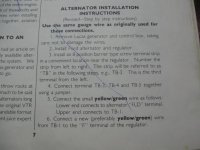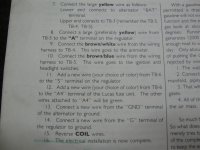Offline
I have done a search on this and similar subjects without finding help for my situation.
The car: 1960 TR3 converted to Negative ground and Motorcraft Alternator with external voltage regulator.
The problem:
1. Generator light is on bright with the engine running.
2. Battery shows the same voltage engine on or off.
The conversion:
I found what looks like the conversion performed to this car with documentation included with it, namely a document titled "More BS about TR's" by Bob Schaller. I have attached an image of the cover, wiring diagram and instruction for conversion that a previous owner had accomplished with this post.
My questions:
1. There are only 2 wires attached to the alternator.
a. Large Yellow attached to the BAT terminal on the Alternator.
b. Small Yellow/Green attached to the FIELD terminal on the Alternator.
The wiring diagram shows a wire from the STAT terminal on the Alternator to TB2. It's not connected to anything. This wire does not exist. I suspect there is an error in the wiring diagram or the instructions?
The wiring diagram shows a ground wire run from the Alternator to ground. Would the physical mounting of the Alternator to the block suffice for this?
Observations:
1. Revving the engine has no effect on battery voltage.
2. The belt is loose compared to the modern cars (Miatas) that I am used to, but is appropriate for this car from what I have read.
3. Placing a DC Voltmeter between TB 3 and ground produce 12.9 VDC at idle.
Thanks for any advice in advance.
The car: 1960 TR3 converted to Negative ground and Motorcraft Alternator with external voltage regulator.
The problem:
1. Generator light is on bright with the engine running.
2. Battery shows the same voltage engine on or off.
The conversion:
I found what looks like the conversion performed to this car with documentation included with it, namely a document titled "More BS about TR's" by Bob Schaller. I have attached an image of the cover, wiring diagram and instruction for conversion that a previous owner had accomplished with this post.
My questions:
1. There are only 2 wires attached to the alternator.
a. Large Yellow attached to the BAT terminal on the Alternator.
b. Small Yellow/Green attached to the FIELD terminal on the Alternator.
The wiring diagram shows a wire from the STAT terminal on the Alternator to TB2. It's not connected to anything. This wire does not exist. I suspect there is an error in the wiring diagram or the instructions?
The wiring diagram shows a ground wire run from the Alternator to ground. Would the physical mounting of the Alternator to the block suffice for this?
Observations:
1. Revving the engine has no effect on battery voltage.
2. The belt is loose compared to the modern cars (Miatas) that I am used to, but is appropriate for this car from what I have read.
3. Placing a DC Voltmeter between TB 3 and ground produce 12.9 VDC at idle.
Thanks for any advice in advance.

 Hey there Guest!
Hey there Guest!
 smilie in place of the real @
smilie in place of the real @
 Pretty Please - add it to our Events forum(s) and add to the calendar! >>
Pretty Please - add it to our Events forum(s) and add to the calendar! >> 









 A friendly reminder - be careful what links you click on here. If a link is posted by someone you don't know, or the URL looks fishy, DON'T CLICK. Spammers sometimes post links that lead to sites that can infect your computer, so be mindful what you click.
A friendly reminder - be careful what links you click on here. If a link is posted by someone you don't know, or the URL looks fishy, DON'T CLICK. Spammers sometimes post links that lead to sites that can infect your computer, so be mindful what you click.